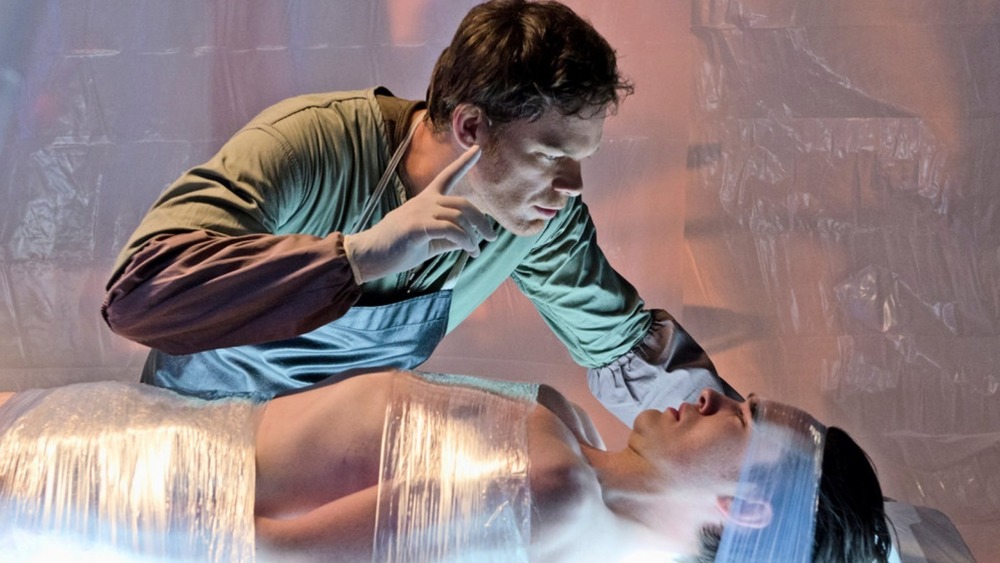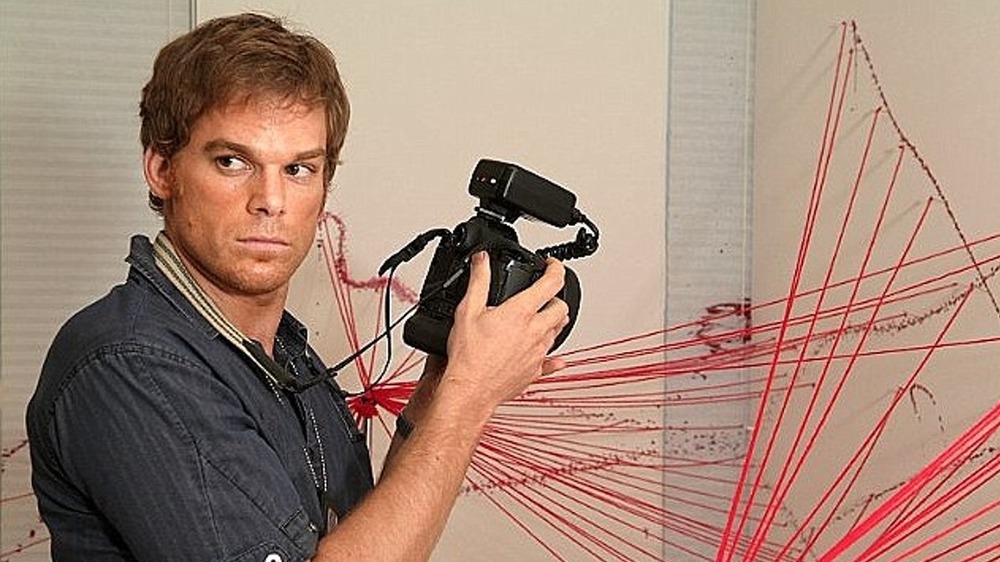The Most Unrealistic Part Of Dexter Isn't What You'd Expect
Dexter Morgan (Michael C. Hall) is set to return in Dexter season 9, and this time, he's up against a brand-new, terrifying villain. With this unexpected yet welcome return of the forensic technician who leads a double life as a serial killer, it's an excellent time to look into the show's past — beyond the rather unsavory aftertaste the ending of Dexter's original run left in many fans' mouths.
Dexter has its share of jaw-dropping moments, but it also contains the occasional absurdity — like the way the main character's many murders would account for a highly noticeable 15 to 20 percent of all Miami's homicides throughout the show's duration. To find out what the most improbable part of the show's murderous shenanigans is, Looper reached out to an expert: Jennifer Shen, former head of the San Diego Police Department crime lab. We learned that the most unrealistic part of Dexter isn't what you'd expect.
Dexter's blood spatter analysis technique makes no sense
Dexter is supposed to be awesome at blood spatter analysis, but it turns out that his grasp of proper methodology isn't quite up to par. This becomes apparent in the pilot episode, in which Dexter studies a bloody crime scene – but both the scene and what he's doing make little sense in the eyes of a professional.
"The scene was comprised of blood spatter resulting from a knife attack. One of the most recognizable and informational patterns at a scene is an arterial spurt. An arterial spurting (or gushing) pattern is a bloodstain pattern(s) resulting from blood exiting the body under pressure from a breached artery. It often forms an arcing pattern consisting of large, individual stains, with a new pattern created each time the heart pumps. As the blood arcs and lands on the surface, it is traveling downward, and often leaves flow patterns as the volume of the drops is significant," Shen begins, commenting on the scene. "In the clip, the pattern on the wall identified as an arterial spurt looks like someone poured a bucket of blood down the wall. When an arterial spurt pattern is present, there are repeated patterns of arcing blood that can be seen as individual drops. This pattern did not represent that."
Dexter's version of the stringing technique doesn't convince Shen either. "Stringing is used to show the viewer where the blood source was located within a scene, using the shape and directionality of the bloodstains. A blood drop will 'point' the way that it was traveling when it hits a surface. Since you know which way it was traveling, it is then easy to determine from where it came," she explains. However, Shen notes that Dexter uses at least 50 strings, which often lead to redundant spots, like blood drops that fell downward (which are virtually impossible to place), pools of blood, and cast-off patterns.
Real stringing, Shen explains, is fairly minimalistic. "This technique is accomplished by identifying five to ten individual and well-formed drops, traveling in an upward direction — drops with a 'pointer' that can be clearly identified," she tells Looper. "These drops are labeled and photographed. A string is affixed to the surface directly above the drop, and traced backwards in three-dimensional space using geometry. Where the strings cross in three-dimensional space is where the bleeding source is located."
By comparison, what happens in Dexter isn't realistic and doesn't make sense. "The elaborate stringing job done on the arterial spurt pattern did not match reality. There were no individual drops, there was no pattern to reconstruct, and all of the drops you could see were traveling downward," Shen explains. "Downward drops are a no-go in blood spatter interpretation, as they could have arched through the air and hit the surface on their way down, making it impossible to ascertain where they originated from. There were no drops, no labels, no rulers — nothing other than lots of strings pulled back to a tripod that bore no relation to the pattern on the wall."
A nonsensical crime scene
Shen also points out that Dexter plays just as fast and loose with the blood patterns as it does with stringing. "Many of the cast-off patterns are strung back to a single location in space. This is contrary to physics, as the knife in this scene was not located in a single place; rather, it moved around quite a bit, slicing and dicing our poor victim," she says. "The patterns are higher and lower on the wall, are not particularly linear (some are sort of snake-shaped), and the drops cannot possibly all originate from one three-dimensional spot in the scene."
What's more, it appears that the victim managed to magically stop bleeding after one of their major arteries was slashed. "Dexter tells our uninformed officer that the first blow hit the carotid artery, leaving the blood bucket pattern on the wall. However, during the ensuing knife dance that followed, the victim managed not to spurt blood all over the rest of the scene," Shen notes. "[That's] highly unlikely, as the victim was still upright and moving around within the scene after that devastating blow, if the ten or 12 cast-off patterns on the other side of the room are to be believed."
Real blood spatter is way more complex than Dexter shows
So, if Dexter takes such a liberal approach toward the main character's day job, what would a realistic version of these bloody crime scenes be like?
According to Shen, it's rarely possible to trace the blood spatter to a single spot like Dexter does, so that wouldn't happen in real life. "It is virtually impossible to string a pattern back to a single point. Stringing is very difficult at scenes, as often the strings come back to an area in space, never a point in space," she says. There would also be much more than string involved — think labels, rulers, and such. Meanwhile, Dexter seems to be happy with his single-point string array, as evidenced by his "stray blood" scene with Angel Batista (David Zayas).
"Blood spatter scenes can be very complicated, or very simple," Shen says. "A single shot may leave very limited spatter; one blow to the head, no spatter. In the case of lots of blood, there were likely repeated events resulting in traumatic injuries. It is very rare to see scenes in which multiple surfaces are covered in blood, and when you do, they are very difficult to reconstruct."
As such, something like the blood room in Dexter's season 1 episode "Seeing Red" would likely be a pretty bad time — as would a scene with multiple patterns.
"All complex scenes require the analyst to identify separate patterns; the size, shape, and breadth of the pattern; and an associated mechanism for the cause of that pattern," Shen says. "For instance, a trail of largely circular drops on the floor indicate a dripping pattern, with gravitational force acting on a blood source, pulling drops of blood to the ground. A pattern consisting of drops ranging from one to three millimeters generally represents a blood source being contacted with force equated to a beating. A mist of drops too small to differentiate is associated with high impact — likely a gunshot, explosive, or car accident."
All in all, Shen says that the blood spatter analysis in Dexter is most definitely "made for TV."



